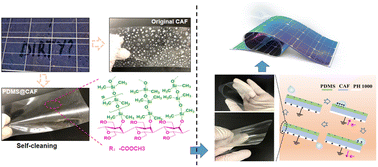Cellulose-based slippery covalently attached liquid surfaces for synergistic rain and solar energy harvesting†
Abstract
For solar cell-triboelectric nanogenerator (TENG) integration, the design of the solid substrate for the TENG device becomes one of the challenges. The TENG needs to have superior contact electrification properties and be transparent so as to ensure light transmittance. Here, by spontaneous polymerization of dichlorodimethylsilane in the absence of any toxic solvent, we have fabricated a controllable liquid-like polydimethylsiloxane brush, featuring hydrophobicity, long-term stability, robustness, and UV resistance. A drop of liquid slides off at tilt angles below 5° and there is dynamic contact angle hysteresis of no more than 10° that can provide strong self-cleaning ability to the solid substrate. This recipe is also applicable to surfaces composed of hydroxyl group-rich cellulose-based surfaces, such as flexible cellulose acetate film (CAF). Importantly, PDMS@CAF, a flexible, transparent, and self-cleaning TENG device with a light transmission rate of 99% or more, was prepared using a conductive polymer film of PH 1000. The hybrid energy harvesting system formed by the combination of this transparent TENG equipped with solar cells is promising for harvesting energy from the environment in different weather conditions.



 Please wait while we load your content...
Please wait while we load your content...